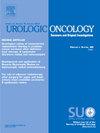National trends in diagnoses of subtype histologies in bladder cancer: A population-based study based on the SEER database
IF 2.3
3区 医学
Q3 ONCOLOGY
Urologic Oncology-seminars and Original Investigations
Pub Date : 2025-07-05
DOI:10.1016/j.urolonc.2025.06.010
引用次数: 0
Abstract
Objective
Accurate diagnosis of histological subtypes is critical to inform optimal clinical management of patients with bladder cancer. However, the diagnosis of histological subtypes remains a challenge and significant interobserver variability persists. We analyzed temporal trends in the diagnosis of histological subtypes in bladder cancer in the US.
Methods
Utilizing the Surveillance, Epidemiology, and End Results (SEER) 17 registry, we evaluated squamous cell carcinoma (SCC), adenocarcinoma (AC), neuroendocrine carcinoma (NC), and other histological subtypes including micropapillary, sarcomatoid, and plasmacytoid variants, diagnosed in cystectomy specimens for patients with pT2-4 primary bladder carcinoma during 2000-2020. We performed Spearman's rank-order correlation to assess temporal trends in the proportions of patients diagnosed with each histology category. We divided the 21-year analysis period into seven 3-year intervals and aggregated data over each interval to improve the precision of proportion estimates. We conducted multivariable logistic regression to adjust for covariates.
Results
We identified 28,160 patients. In unadjusted analysis, the proportion of patients diagnosed with SCC decreased significantly over time (ρ -0.86, P = 0.02). The proportion diagnosed with other histological subtypes increased significantly over time (ρ 1.00, P = 0.001). After adjusting for covariates, a later year of diagnosis was associated with significantly increased odds of NC (OR 1.07, P = 0.001) and other histological subtype diagnoses (OR 1.16, P < 0.001).
Conclusions
Variant histological subtypes of muscle-invasive bladder cancer in cystectomy specimens from patients in the US have increased over time. These trends could reflect increasing awareness of histological subtypes among pathologists.
膀胱癌亚型组织学诊断的国家趋势:基于SEER数据库的基于人群的研究。
目的:准确诊断膀胱癌的组织学亚型对指导膀胱癌患者的最佳临床治疗至关重要。然而,组织学亚型的诊断仍然是一个挑战,显著的观察者之间的差异仍然存在。我们分析了美国膀胱癌组织学亚型诊断的时间趋势。方法:利用监测、流行病学和最终结果(SEER) 17注册表,我们评估了2000-2020年期间pT2-4原发性膀胱癌患者膀胱切除术标本中诊断出的鳞状细胞癌(SCC)、腺癌(AC)、神经内分泌癌(NC)和其他组织学亚型,包括微乳头状、肉瘤样和浆细胞样变异。我们采用Spearman的秩序相关性来评估诊断为每种组织学类别的患者比例的时间趋势。我们将21年的分析期划分为7个3年的区间,并在每个区间内汇总数据,以提高比例估计的精度。我们进行了多变量逻辑回归来调整协变量。结果:我们确定了28,160例患者。在未经调整的分析中,诊断为SCC的患者比例随时间显著下降(ρ -0.86, P = 0.02)。诊断为其他组织学亚型的比例随着时间的推移而显著增加(ρ 1.00, P = 0.001)。在调整协变量后,诊断年份越晚,NC (OR 1.07, P= 0.001)和其他组织学亚型诊断的几率显著增加(OR 1.16, P < 0.001)。结论:美国患者膀胱切除术标本中肌肉浸润性膀胱癌的不同组织学亚型随着时间的推移而增加。这些趋势可能反映了病理学家对组织学亚型的认识不断提高。
本文章由计算机程序翻译,如有差异,请以英文原文为准。
求助全文
约1分钟内获得全文
求助全文
来源期刊
CiteScore
4.80
自引率
3.70%
发文量
297
审稿时长
7.6 weeks
期刊介绍:
Urologic Oncology: Seminars and Original Investigations is the official journal of the Society of Urologic Oncology. The journal publishes practical, timely, and relevant clinical and basic science research articles which address any aspect of urologic oncology. Each issue comprises original research, news and topics, survey articles providing short commentaries on other important articles in the urologic oncology literature, and reviews including an in-depth Seminar examining a specific clinical dilemma. The journal periodically publishes supplement issues devoted to areas of current interest to the urologic oncology community. Articles published are of interest to researchers and the clinicians involved in the practice of urologic oncology including urologists, oncologists, and radiologists.

 求助内容:
求助内容: 应助结果提醒方式:
应助结果提醒方式:


